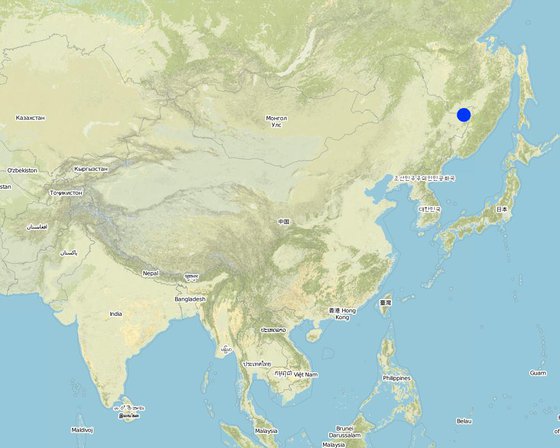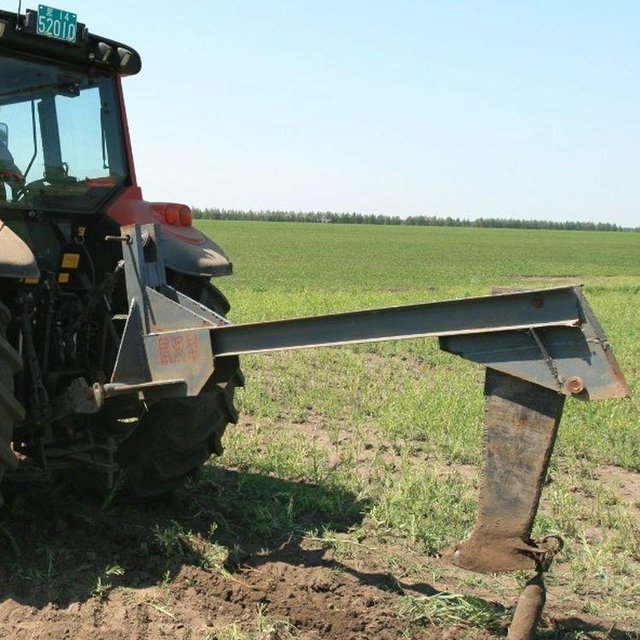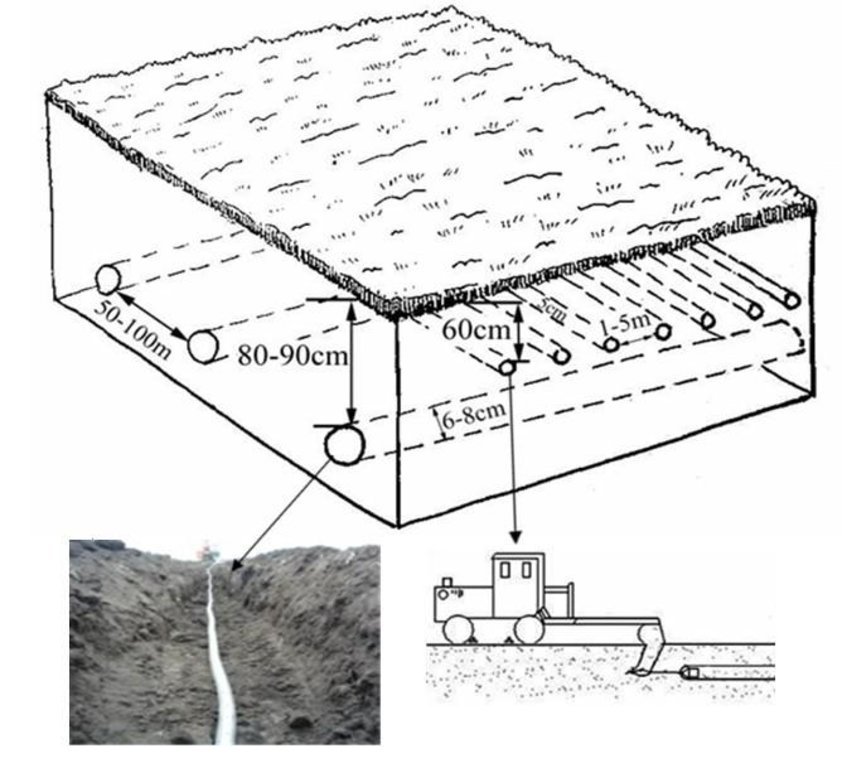



Rat tunnels are suitable for the regions with sticky and heavy soil, thick soil layer, and lower infiltration rates, high underground water level and where waterlogs are very likely to happen. By applying the rat tunnels, infiltration can be increased, soil salinization can be prevented without affecting the growth of the crops and occupying croplands. Good effect can be achieved by combining rat tunnels with closed conduits in application. Closed drainage refers to burying the drain pipes underground and letting the underground water flow along the fissures between the pipes and penetrate into the tubes and drained. In a field, if rat tunnels and closed conduits are combined for use, the rat tunnels constitute the first-grade drainage system, the closed conduits constitute the second-grade drainage system; the stagnant water in the plough layer penetrates through the soil and rat fissures and converges into the rat tunnels; While draining the water inside themselves to the outside, the rat tunnels collect the inside stagnant water and guide the water into the closed conduits, through which the water is discharged. In this way, the surface water can be discharged in a relatively thorough way.
Increase of soil infiltration, rapid discharge of direct surface runoffs, prevention of soil salinization.
In building such a project, the closed conduits should be built first, followed by the building of the rat tunnels; the closed conduits should be under the rat tunnels, the included angle between a closed conduit and a rat tunnel should be 90°.
The gap between two neighboring laid closed conduits should be 50m-100m. The burying depth of a closed conduit should be 80cm-90cm, the area around the closed conduit should be evenly laid with a layer of coarse gravels 5-8cm in thickness. After the project on the closed conduits in a field is accomplished, restore the flatness of the field surface, then undertake the operation on the rat tunnels.
In building the rat tunnels, a tractor is directly applied to pull the mole plough in accordance with the designed distances. When the tractor moves forward, the mole plough goes deep into a specified depth(generally 60cm) of soil layer and generates through piercing the soil along the direction of the forward motion of the tractor a tunnel(rat tunnels) whose diameter is equal to bullet diameter and which is in parallel with the ground surface. The separation distance between two neighboring rat tunnels is 1-5m. The service life is generally 2-5 years. If the rate of flow of a field obviously decreases, new rat tunnels should be built by averting the original routes.
After a rainfall, check whether the rat tunnels have collapsed. The service life of the newly laid closed conduits is over 20, however, new rat tunnels should be built every two years.
Rat tunnels are mainly distributed on the Three River Plain, which is the largest marsh distribution area. It has a total population of about 8.625, with the population density being about 79/km2. With the annual average temperature being 1℃-4℃,being warm in summer with the average temperature being over 22℃, having an annual amount of precipitation of 500-600 mm with the rainfall seasons mainly concentrated in the hot seasons from June to August, the Three River Plain is suitable for the growth of crops. The area is affluent in water resources, with the total quantity reaching about 18.764 billion/m3. In this area, the per capita cultivated land area is about 5 times of the average level in China. There are also about 2.52 millions of theropencedrymion distributed in the terrains with low mountains and hills.

ទីតាំង: San Jiang Plain, Hei Longjiang, ប្រទេសចិន
ចំនួនទីកន្លែងបច្ចេកទេស ដែលវិភាគ:
ការសាយភាយនៃបច្ចេកទេស: ត្រូវបានផ្សព្វផ្សាយត្រឹមតំបន់មួយ (approx. > 10,000 គម2)
តើស្ថិតក្នុងតំបន់ការពារអចិន្ត្រៃយ៍?:
កាលបរិច្ឆេទនៃការអនុវត្ត: 10-50 ឆ្នាំ
ប្រភេទនៃការណែនាំឱ្យអនុវត្តន៍៖






| បញ្ជាក់ពីធាតុចូល | ឯកតា | បរិមាណ | ថ្លៃដើមក្នុងមួយឯកតា (Ren Min Bi) | ថ្លៃធាតុចូលសរុប (Ren Min Bi) | % នៃថ្លៃដើមដែលចំណាយដោយអ្នកប្រើប្រាស់ដី |
| កម្លាំងពលកម្ម | |||||
| labour | ha | 1,0 | 64,0 | 64,0 | |
| សម្ភារៈ | |||||
| first machine | ha | 1,0 | 224,0 | 224,0 | |
| second machine | ha | 1,0 | 24,0 | 24,0 | |
| សម្ភារៈសាងសង់ | |||||
| corrugated plastic conduit | ha | 1,0 | 640,0 | 640,0 | |
| ថ្លៃដើមសរុបក្នុងការបង្កើតបច្ចេកទេស | 952.0 | ||||
| ថ្លៃដើមសរុបក្នុងការបង្កើតបច្ចេកទេសគិតជាដុល្លារ | 152.32 | ||||
| បញ្ជាក់ពីធាតុចូល | ឯកតា | បរិមាណ | ថ្លៃដើមក្នុងមួយឯកតា (Ren Min Bi) | ថ្លៃធាតុចូលសរុប (Ren Min Bi) | % នៃថ្លៃដើមដែលចំណាយដោយអ្នកប្រើប្រាស់ដី |
| សម្ភារៈ | |||||
| second machine | ha | 1,0 | 24,0 | 24,0 | |
| ថ្លៃដើមសរុបសម្រាប់ការថែទាំដំណាំតាមបច្ចេកទេស | 24.0 | ||||
| ថ្លៃដើមសរុបសម្រាប់ការថែទាំដំណាំតាមបច្ចេកទេសគិតជាដុល្លារ | 3.84 | ||||
Local peasants learn some knowledges of soil and water conservation though this technology.